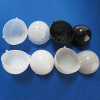ingalfsan
New Member
Hello dear friends.
I need your valuable help for a little circuit I'm designing.
It is a small circuit to incorporate a delay to a PIR motion sensor that activates a spray that releases compressed air to drive away birds, cats, dogs etc. The detail is that once the sensor is activated, it will be inactive for 5 or 10 minutes (this will prevent it from being retriggered during that time). For space reasons (the PCB must have 2 "x 1.5") I have been trying to do it using only BC547 transistors. Anyway, a circuit with a classic NE555 would also serve me!
The PIR I'm using is a naked PIR without a stabilization circuit. Any ideas are welcome!
The circuit I have done so far uses a darlington array and keeps me on a led for about 30 seconds after activating the switch (which is supposed to act as a PIR sensor). I really do not have a clue where to start. I have done several circuits with NE555 in astable and monostable mode, but that if I keep an active circuit for a second and inactive for 5 minutes I have no idea how to do it. I have a lot of experience programming Arduino, PIC, Raspberry, IoT applications (I am at your command), but some basic electronics issues surpass me.
Thank you very much in advance.
Attached images and Proteus files of what I have done so far.


I need your valuable help for a little circuit I'm designing.
It is a small circuit to incorporate a delay to a PIR motion sensor that activates a spray that releases compressed air to drive away birds, cats, dogs etc. The detail is that once the sensor is activated, it will be inactive for 5 or 10 minutes (this will prevent it from being retriggered during that time). For space reasons (the PCB must have 2 "x 1.5") I have been trying to do it using only BC547 transistors. Anyway, a circuit with a classic NE555 would also serve me!
The PIR I'm using is a naked PIR without a stabilization circuit. Any ideas are welcome!
The circuit I have done so far uses a darlington array and keeps me on a led for about 30 seconds after activating the switch (which is supposed to act as a PIR sensor). I really do not have a clue where to start. I have done several circuits with NE555 in astable and monostable mode, but that if I keep an active circuit for a second and inactive for 5 minutes I have no idea how to do it. I have a lot of experience programming Arduino, PIC, Raspberry, IoT applications (I am at your command), but some basic electronics issues surpass me.
Thank you very much in advance.
Attached images and Proteus files of what I have done so far.
Attachments
Last edited:









